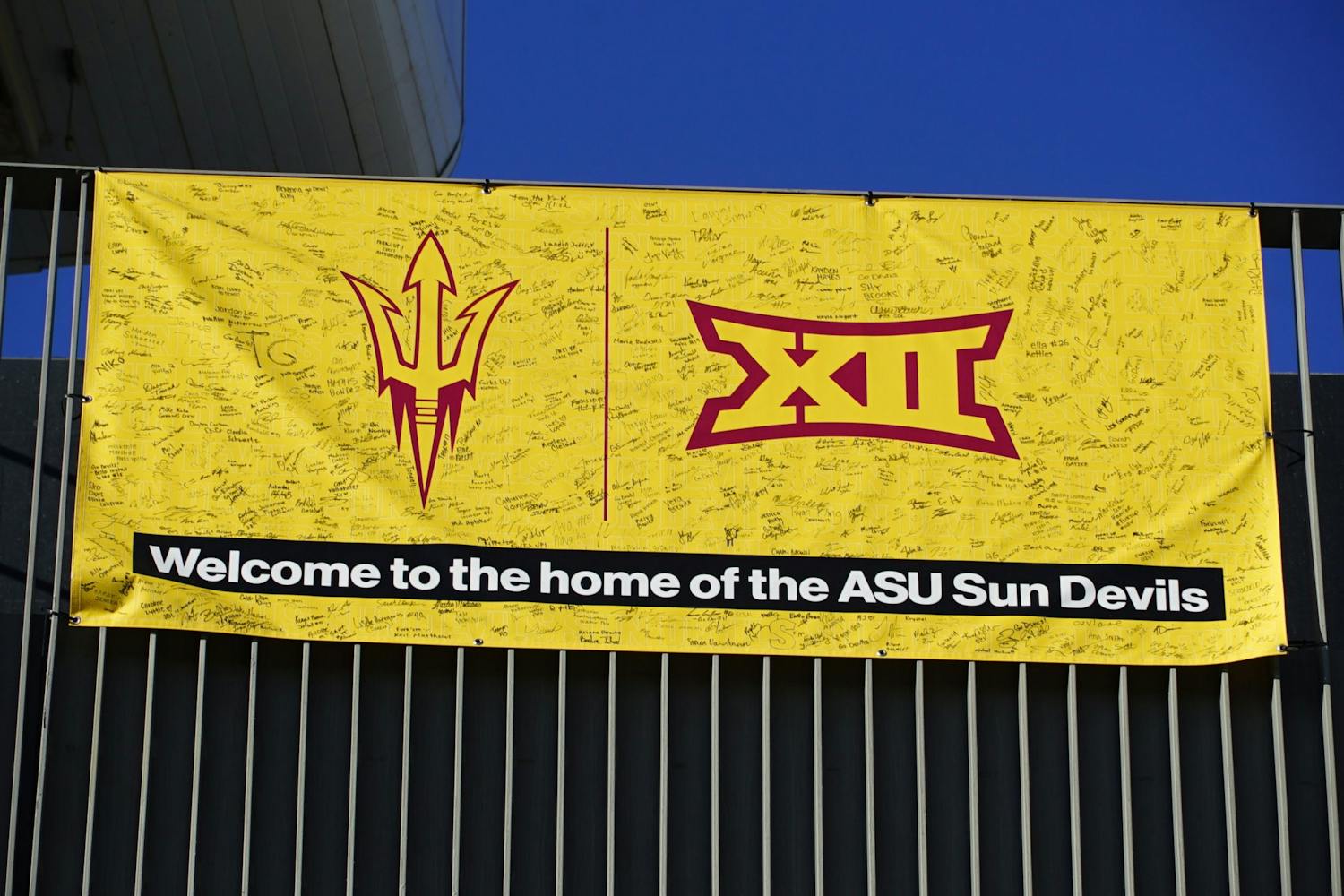 Members of the ASU baseball team catch a ceremonial first pitch at Phoenix Municipal Stadium on April 23, 2013. The stadium will be the new home for the Sun Devils starting in 2015. (Photo by Danny Shapiro)
Members of the ASU baseball team catch a ceremonial first pitch at Phoenix Municipal Stadium on April 23, 2013. The stadium will be the new home for the Sun Devils starting in 2015. (Photo by Danny Shapiro)Among a host of facility upgrades that have augmented the ASU baseball program's move to Phoenix Municipal Stadium, the latest stadium addition is a concept that has yet to gain a permanent footing in Division I college baseball — a student section.
Though student attendance is an issue across multiple Division I sports, baseball is notorious for sparse crowds, relative to the financial powerhouses that are basketball and football.
A draw for many college baseball fans, whether they are alumni or just local university boosters, is that college baseball stadiums tend to possess a degree of intimacy which is difficult to replicate at the professional level.
Selecting Phoenix Muni as the new home of Sun Devil baseball addresses this issue on multiple fronts: First, it being a Cactus League park with 30 years of use by the stadium's previous tenant, the Oakland Athletics, is an indicator that Muni can be a long-term solution for the program.
The expanded seating capacity of 8,775 is an opportunity for more ticket revenue, though only slightly bigger than now-defunct Packard Stadium, which held 7,875 people.
 Junior pitcher Ryan Kellogg fires from the mound during Saturday's intrasquad scrimmage on Feb. 7, 2015, at Phoenix Municipal Stadium. (J. Bauer-Leffler/ The State Press)
Junior pitcher Ryan Kellogg fires from the mound during Saturday's intrasquad scrimmage on Feb. 7, 2015, at Phoenix Municipal Stadium. (J. Bauer-Leffler/ The State Press)While saying goodbye to Packard was more difficult for some diehards than others, the University was never at much risk of alienating its core fanbase, which consists of alumni and season ticket holders, who have been receptive to the team's new vision for its current real estate.
ASU has consistently ranked in the top five in Pac-12 in overall attendance thanks to its dedicated nucleus, averaging 2,844 fans per game, good for a cumulative 85,324 over 14 home games in 2014, per an NCAA report.
Conversely, LSU's Alex Box Stadium/Skip Bertman Field sits atop the list, gradually adding seating and averaging sellouts in nearly every home game. Collectively, Tigers fans dominated the No. 2 team on the list (Arkansas) in overall attendance, beating out the Bulldogs by more than 100,000 fans with a total of 424,321 in 39 home games last year.
Of course, increasing capacity doesn't solve the school's inherent problem, which is the lack of a consistent student presence. Even though the Sun Devil faithful were No. 21 overall in total turnout, average Packard Stadium crowds in the park's final year fell well short of capacity, and student attendance is often so low that isn't even measured.
 The new plaza of Phoenix Municipal Stadium features highlights of the ASU baseball team's history. (J. Bauer-Leffler/ The State Press)
The new plaza of Phoenix Municipal Stadium features highlights of the ASU baseball team's history. (J. Bauer-Leffler/ The State Press)Designating a student section at Muni is a bold gamble, with plenty of reward to offset the potential risk that comes with playing at an old spring training site that is miles off campus.
The student reception on Twitter seems to be generally positive, and while the social media buzz isn't quite enough to project how many of them will attend games, there is a strong student contingent, even if it can't be compared to a Saturday night at Sun Devil Stadium in October.
It's not yet clear how much the "Inferno" student section, a hit at football games, will mesh with the culture and tradition of ASU baseball. But for fans looking for a precedent, they might find a more appropriate model with the "942 Crew," the hottest college basketball student section in the land.
"(Associate Athletic Director Bill Kennedy) and the 942 Crew are going to play a big part in getting this thing filled," said Brendan Cunningham, ASU's Director of Baseball Operations.
In terms of scale, an atmosphere similar to the 942 Crew is a much more realistic expectation for student involvement with the baseball program. Having just set a record of 3,023 students in attendance for the game against Utah, this group has relatively been built from scratch, thanks to the efforts of many of the same students behind the "Camp Fargo" effort during football season.
"Part of the 942 Crew's (charm) is that we have to keep it a secret," Cunningham said. "We'll unveil them throughout the year. We'll continue working throughout the season, now that we've had a dry run, and can see how the games go. It'll be a work in progress, but we're excited to see how the games go."
Thanks in large part to the athletic fee bill essentially nullifying the cost of attending ASU sporting events up front (baseball was unaffected by this change) ultimately, the student attendance numbers will reflect the efforts of the athletic department to reach out to students, who will need to bring with them only a student ID and an appetite for nine long innings with them to the gate at Phoenix Muni.
Pac-12 Attendance Rankings (2014)
1. Oregon State 2,932
2. ASU 2,844
3. Arizona 2,521
4. Stanford 1,646
5. Oregon 1,645
Reach the reporter at smodrich@asu.edu or on Twitter @StefanJModrich
Like State Press Sports on Facebook and follow @statepressport on Twitter.




